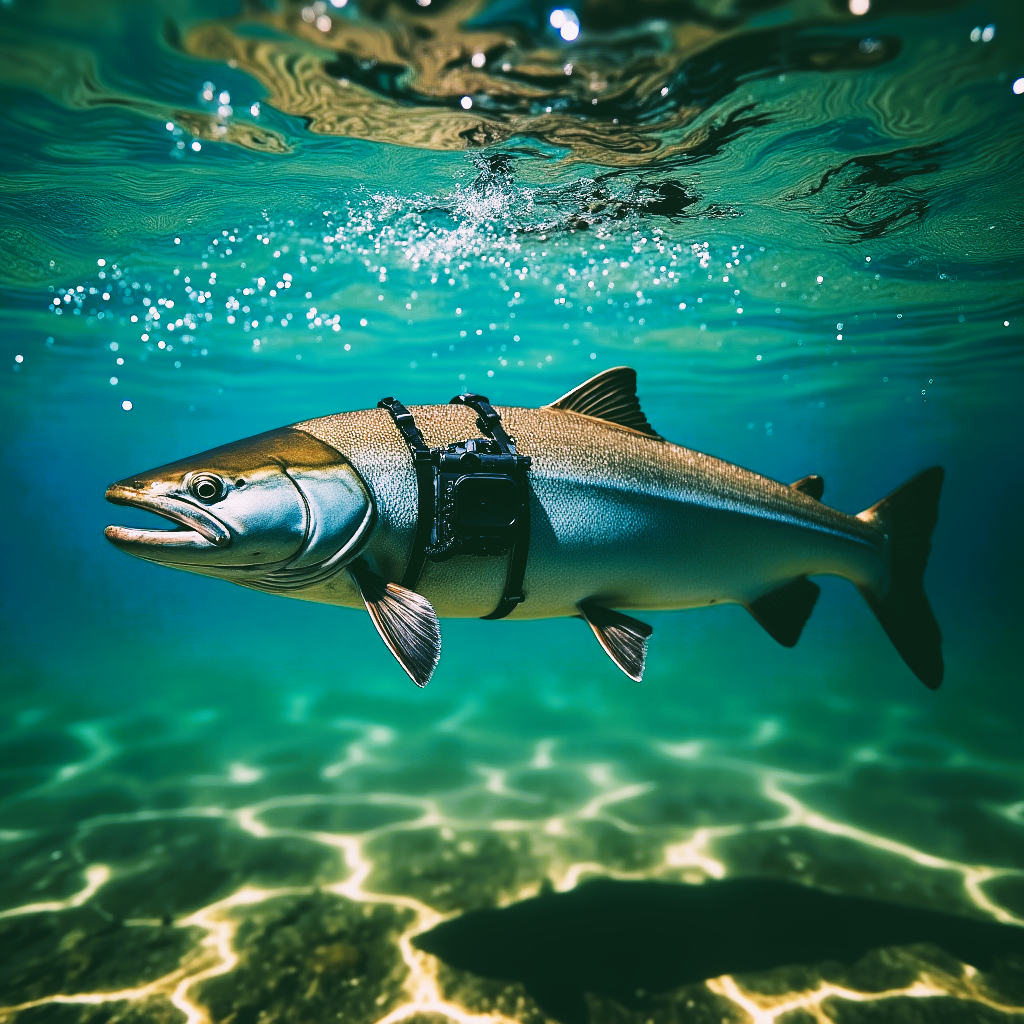Field Report: On the Misadventure of the Instrumented Salmon
Filed Under: Aquatic Observation, Experimental Methodologies, Unanticipated Outcomes
Filed by: Archivist Pro Tem [Redacted]
Ledger Reference: 9.3.21-b
It is with a measured blend of scholarly candor and institutional dismay that we record the events surrounding last Thursday’s experiment—an undertaking we had privately considered to be a methodological leap forward in littoral observation, and which, regrettably, will now reside in the archives under the less triumphant classification of “Case Study in Field Unpredictability.”
The aim was nothing less than groundbreaking: to affix a precision-calibrated aquatic imaging device (a GoPro Hero3, graciously provided by Concordant [Name Redacted]) to a live Oncorhynchus tshawytscha specimen for the purpose of capturing immersive, first-person documentation of submerged terrain along the Two Rivers breakwater. The salmon would also be outfitted with a a Concordant Locational Medallion (Air Tag). Such footage, we hypothesized, might yield unprecedented insight into sandbar morphology, benthic artifact placement, and—most tantalizingly—the possible presence of timbers, fittings, or other debris associated with the wreck of the famed Christmas Tree Ship.
The preparation phase was exhaustive. Committee meetings debated the hydrodynamics of dorsal placement versus lateral harnessing. A subcommittee produced a 17-page treatise on camera buoyancy offset. A prototype rig—crafted from paracord, stainless steel swivels, and salvaged neoprene—was subjected to tank trials in the Chapter House courtyard fountain. Confidence was high.
Deployment commenced in ideal conditions: light chop, favorable current, and a subject fish of commendable size and vigor. Upon release, the specimen exhibited the kind of purposeful acceleration chronicled only in the finer annals of ichthyological field literature. Unfortunately, the trajectory proved… singular. Instead of the anticipated exploratory meander, the salmon swam with unwavering determination into the open channel, passing beneath the hull of the S.S. Badger in a moment of brief but cinematic footage that, for those present, elicited involuntary gasps.
At precisely 02:17 the following morning, the tracking beacon’s signal shifted abruptly to the Manitowoc Marina fish cleaning station—a development that elicited a round of controlled but audible sighs from the Committee. The device was retrieved the next day, returned to the marina’s lost-and-found in pristine condition, accompanied by a handwritten note reading:
“Cool camera. Sorry about your fish! thanks – Gary”
The key footage—though limited to 14 seconds of high-velocity bubbles, three frames of propeller blades, and a long, static shots of an aluminum cleaning table—will nonetheless be accessioned into the Order’s South Alcove Exhibit under the title “An Exercise in Optimism: Volume I.”
It is the formal position of the Committee that, while the experiment failed to yield primary data, it successfully illuminated the inherent unpredictability of field-based collaboration with non-consenting aquatic subjects. In this regard, it may prove more instructive to future scholarship than had it succeeded in the conventional sense.
Comments:
E.M.T.: “The methodology was sound. The fish’s poor grasp of navigation cannot be held against us.”
R.J.H.: “Sound? It was spectacle. We’ve drifted from the pursuit of knowledge into the pursuit of novelty.”
P.A.V.: “Novelty? Sir, it was an act of maritime ingenuity unseen since Cousteau’s era!”
C.L.W.: “If Cousteau had done this, the fish would have brought back a map, a signed affidavit from the Christmas Tree Ship, and possibly a better camera angle.”
S.G.C.: “The real issue is the Committee’s overreliance on improvisational rigging. The paracord looked like something from a youth summer camp.”
D.K.M.: “Better than the duct-tape monstrosity you proposed. We’re scholars, not hobbyists.”
S.G.C.: “Scholars don’t lose their research subjects under ferry hulls.”
E.M.T.: “The ferry incident was an unforeseen variable in an otherwise exemplary deployment.”
R.J.H.: “Unforeseen variable? It was parked in plain sight!”
P.A.V.: “The Badger moves, R.J.H., it is not a static feature of the shoreline.”
C.L.W.: “Gentlemen—and Ms. S.G.C.—if I may: perhaps next time we attach the camera to something less migratory. Like a buoy. Or a rock.”
D.K.M.: “And produce what, exactly? Three hours of stationary footage? Yes, riveting
